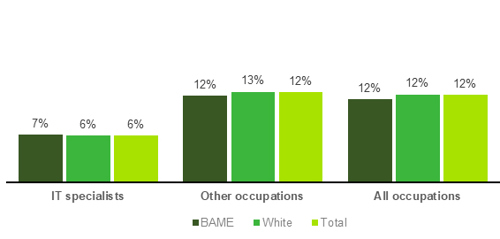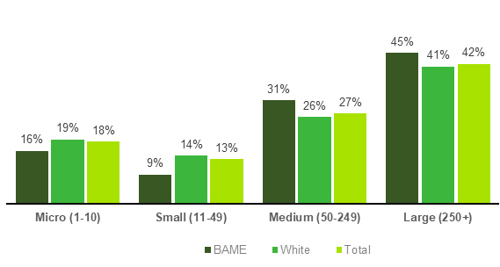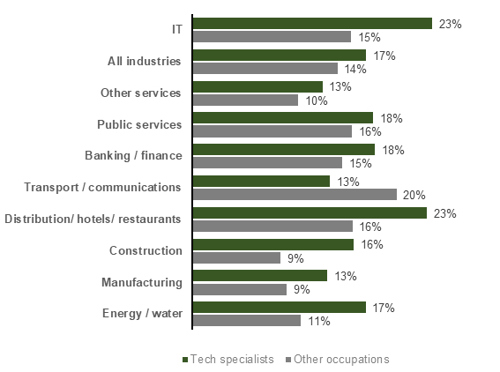Employment characteristics
Self-employment
During 2022, it is estimated that 12% of all UK workers and 6% of IT specialists were working on a self-employed basis. Though there was no difference in incidence of self-employment amongst BAME/white workers as a whole, amongst IT specialists, self-employment was slightly more common amongst those from BAME groups (7% and 6% for BAME/white IT specialists respectively).
Ethnicity and the incidence of self-employment (2022)

Source: Analysis of ONS Quarterly Labour Force Survey by BCS
Employees and size of workplace
IT specialists working as employees are, perhaps understandably, more likely than others to be employed within larger workplaces[2] (i.e. as micro/small sites are less likely to have an in-house function) and whilst just 30% of UK employees as a whole were working in larger sites during 2022 (those with 250 or more staff), a figure of 42% was recorded for IT specialist employees.
The figure was still higher amongst BAME IT specialists however, of which 45% were employed in workplaces with 250 or more staff.
Also notable in the chart overleaf is the fact that BAME IT specialists were less likely to be working at small sites than other IT staff – comparison figures in this case being 9% for BAME specialists and 14% for other IT staff.
Ethnicity and size of workplace (2022)

Source: Analysis of ONS Quarterly Labour Force Survey by BCS
Industry of employment
Over one half (54%) of all BAME IT specialists were working in IT businesses in 2022 - a higher proportion than for those of white ethnic origin (44%) and IT specialists as a whole (46% of which were working in IT firms during this period). After IT, the next largest employer of IT specialists (BAME/white) were banking/ finance firms (18% and 20% respectively) and the Public sector (13% and 15%).
When considering levels of representation however - IT firms, along with distribution/hotels and restaurants were found have the highest proportion of BAME IT specialists (23%) during 2022.
Conversely, the level of BAME representation amongst IT staff was lowest within the manufacturing, transport/communications and ‘other service’ sectors where just 13% of IT specialists were from BAME ethnic groups.
BAME employees by occupation and industry (2022)

Source: Analysis of ONS Quarterly Labour Force Survey by BCS
* Five-year average
[2]The LFS asks individuals about the number of employees at their workplace as opposed to enterprise / organisation as a whole.













